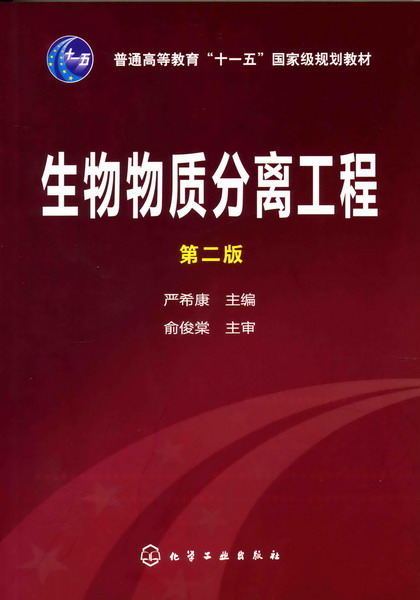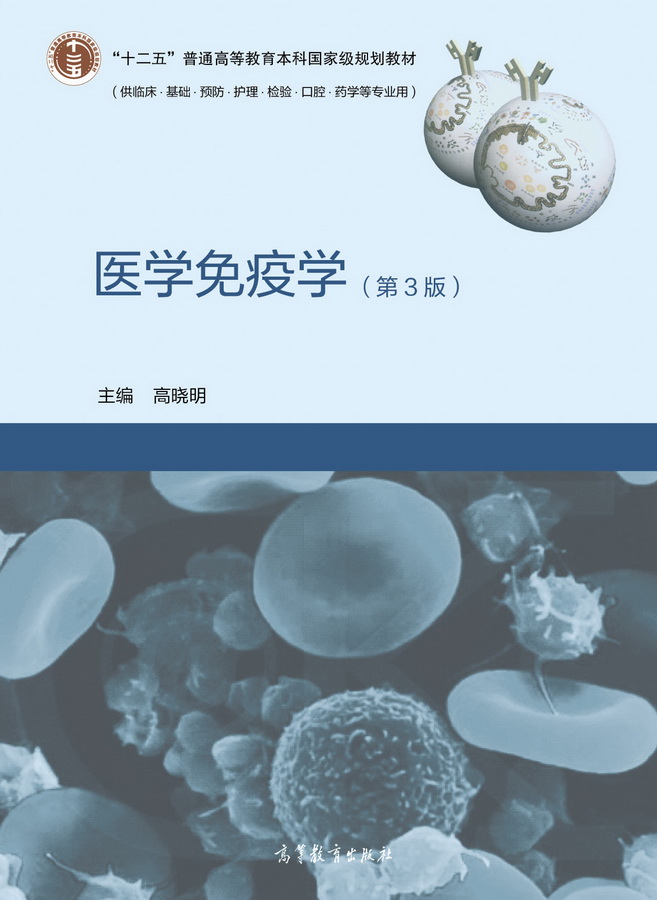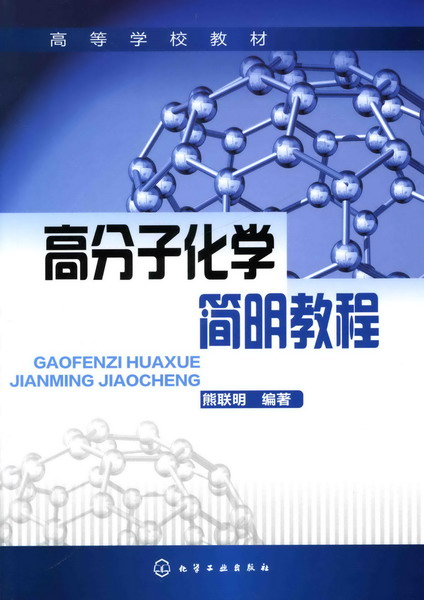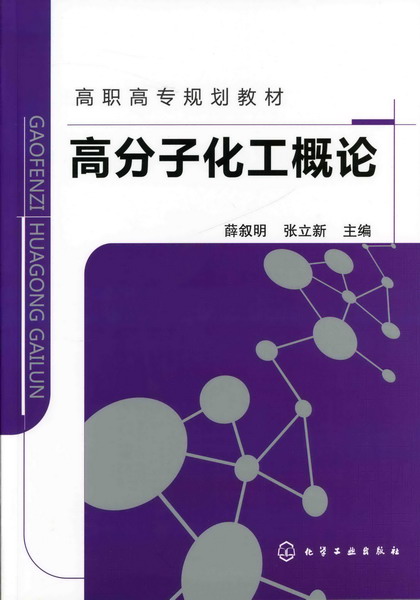医学免疫学(第2版)
作者: 高晓明
出版时间:2011-01-14
出版社:高等教育出版社
- 高等教育出版社
- 9787040297706
- 2
- 142209
- 0049151932-8
- 平装
- 16开
- 2011-01-14
- 560
- 305
- 医学
- 基础医学
《医学免疫学-第2版》的内容分为前后相连、循序渐进的五个部分,每个部分保持相对独立和完整,读者可以选择某一个部分进行集中研读,也可以依次通读,还可以将第一部分与后面的任何一个部分组合起来学习。为了保证基本概念的准确表述,本书中所有大、小标题均以中、英文对照书写,同时在文字叙述中给出常用或者尚无统一译法的专业英文名词。
I 免疫系统与免疫学简介
1 绪论
1-1 病原体、瘟疫与免疫
1-2 免疫学发展简史
1-3 免疫学概要
2 免疫器官和免疫细胞
2-1 中枢免疫器官
2-2 外周免疫器官
2-3 粒细胞
2-4 单核-巨噬细胞与树突细胞
2-5 淋巴细胞
2-6 淋巴细胞循环
3 免疫细胞膜分子
3-1 免疫细胞膜分子概况
3-2 黏附分子
3-3 T细胞的主要膜分子
3-4 B细胞的主要膜分子
3-5 免疫球蛋白超家族
4 免疫系统的识别对象
4-1 固有免疫系统识别“危险信号”
4-2 抗原的概念
4-3 抗原的分类
4-4 半抗原
4-5 超抗原与丝裂原
4-6 免疫佐剂
5 免疫系统的进化
5-1 免疫组织与器官的进化
5-2 免疫细胞的进化
5-3 免疫分子的进化
II 固有免疫系统及其应答
6 固有免疫应答
6-1 固有免疫的一般特点
6-2 固有样淋巴细胞
6-3 肥大细胞
6-4 干扰素与组织细胞的自卫功能
6-5 固有免疫应答的调节
7 补体系统
7-1 补体系统的组成与生物化学特点
7-2 补体系统激活的替代途径
7-3 补体系统激活的经典途径
7-4 补体系统激活的MBP途径
7-5 补体应答的终末途径
7-6 补体受体和补体系统的其他生物学功能
7-7 补体系统的调节
8 吞噬细胞
8-1 吞噬细胞的识别受体
8-2 吞噬细胞与炎症
8-3 吞噬
8-4 吞噬细胞内杀伤与消化的机制
8-5 巨噬细胞的其他生理功能
9 NK细胞及其介导的免疫应答
9-1 NK细胞的特点
9-2 NK细胞受体
9-3 NK细胞的生物学功能
III 适应性免疫系统及其应答
10 主要组织相容性抗原及其基因复合体
10-1 MHC分子的基本结构与组织分布
10-2 人MHC基因的结构与多态性
10-3 MHC分子的抗原肽结合单位
10-4 蛋白质抗原的处理与呈递
10-5 呈递脂类抗原的CD1分子
11 抗体分子及其基因重排
11-1 抗体分子的基本结构及其多样性
11-2 五类抗体分子的主要特点
11-3 抗体分子的Fc受体
11-4 免疫球蛋白分子超家族
11-5 免疫球蛋白基因及其重排
12 T细胞受体及其基因重排
12-1 T细胞受体的结构和功能
12-2 TCR基因及其重排
13 淋巴细胞发育
13-1 B细胞发育
13-2 T细胞发育
13-3 NK细胞和NKT细胞的发育
14 适应性细胞免疫应答
14-1 免疫应答的启动
14-2 抗原特异性T细胞的活化与扩增
14-3 细胞免疫应答的效应
14-4 免疫记忆
15 细胞因子及其受体
15-1 细胞因子的主要特点
15-2 细胞因子受体的分类与命名
15-3 主要由固有免疫细胞产生的细胞因子
15-4 主要由Th1细胞分泌的细胞因子
15-5 主要由Th2细胞分泌的细胞因子
15-6 主要由Th17细胞分泌的细胞因子
15-7 细胞生长因子
15-8 趋化性细胞因子
15-9 细胞因子网络
15-10 细胞因子与临床
16 适应性体液免疫应答
16-1 体液免疫应答的一般规律
16-2 抗体生成的理论
16-3 体液免疫应答的细胞生物学基础
16-4 抗原与抗体的结合
16-5 体液免疫应答的效应
17 免疫耐受与免疫调节
17-1 天然免疫耐受与获得性免疫耐受
17-2 免疫耐受的形成机制
17-3 适应性免疫应答的调节
IV 临床免疫学
18 抗感染免疫
18-1 抗病毒免疫应答
18-2 抗细菌免疫应答
18-3 抗寄生虫免疫应答
18-4 针对病原微生物的免疫记忆
18-5 抗感染免疫应答所造成的免疫病理损伤
18-6 病原微生物的免疫逃逸机制
19 原发性免疫缺陷病
19-1 原发性免疫缺陷病的临床特点
19-2 重症联合免疫缺陷病
19-3 T淋巴细胞缺陷
19-4 B淋巴细胞缺陷
19-5 单核-巨噬细胞和粒细胞缺陷
19-6 补体缺陷
19-7 原发性免疫缺陷病的治疗
20 继发性免疫缺陷
20-1 非感染因素造成的免疫缺陷
20-2 HIV和获得性免疫缺陷综合征
20-3 HIV感染与损伤靶细胞的机制
20-4 针对HIV感染的免疫应答
20-5 艾滋病的预防和治疗
21 超敏反应
21-1 过敏反应、变态反应与超敏反应
21-2 变应原及Ⅰ型超敏反应
21-3 Ⅱ型超敏反应
21-4 Ⅲ型超敏反应
21-5 Ⅳ型超敏反应
21-6 各型超敏反应之间的关系
22 自身免疫病
22-1 自身免疫病的一般特点
22-2 自身免疫耐受的不完全性
22-3 激活人体内自身抗原特异性T细胞的途径
22-4 自身免疫应答造成病理损伤的机制
22-5 遗传、环境与自身免疫病
22-6 常见自身免疫病举例
22-7 自身免疫病的治疗
23 肿瘤免疫
23-1 肿瘤发生的基本原理
23-2 肿瘤抗原
23-3 抗肿瘤免疫效应机制
23-4 肿瘤细胞免疫逃逸的机制
23-5 肿瘤的免疫治疗与预防
24 移植免疫
24-1 器官和组织移植的一般规律
24-2 同种异型移植排斥反应的特点
24-3 同种异型移植排斥反应的免疫学基础
24-4 同种异型移植排斥反应的防治
24-5 异种移植排斥反应及其应对策略
V 免疫相关技术与应用
25 免疫学技术及应用
25-1 体外抗原-抗体反应
25-2 免疫细胞的检测
25-3 补体活性的测定
25-4 细胞因子的检测
25-5 其他常用的免疫学技术
26 疫苗及预防接种
26-1 疫苗的基本原理
26-2 现代疫苗的种类
26-3 疫苗接种与计划免疫
26-4 新疫苗研制
27 单克隆抗体技术
27-1 单克隆抗体技术原理
27-2 人单克隆抗体技术
27-3 人源化抗体技术
27-4 单链抗体与双特异性抗体
27-5 抗体库技术
附录 常用免疫学名词
主要参考文献
I An Overview of the Immune System and Immunology
1 An Introduction to Immunology
1-1 Pathogens, Plagues and Immunity
1-2 A Brief History of Immunology
1-3 Sketches of Immunology
2 Organs and Cells of the Immune System
2-1 Central Lymphoid Organs
2-2 Peripheral Lymphoid Organs
2-3 Granulocytes
2-4 Monocytes, Macrophages and Dendritic Cells
2-5 Lymphocytes
2-6 Lymphocyte Traffic
3 Membrane Molecules of Immune Cells
3-1 General Features of Membrane Molecules of Immune Cells
3-2 Adhesion Molecules
3-3 Membrane Molecules of T Cell
3-4 Membrane Molecules of B Cell
3-5 Immunoglobulin Superfamily
4 Structures Recognized by the Immune System
4-1 Innate Immune System Recognizes“Danger Signal”
4-2 Concept of Antigens
4-3 Classification of Antigens
4-4 Hapten
4-5 Superantigen and Mitogen
4-6 Adjuvants
5 Evolution of the Immune System
5-1 Evolution of the Immune Tissues and Organs
5-2 Evolution of the Immune Cells
5-3 Evolution of the Immune Molecules
II Innate Immune System and Its Responses
6 Innate Immune Responses
6-1 General Features of the Innate Immunity
6-2 Innate-like Lymphocytes, ILL
6-3 Mast Cells
6-4 Defensive Function of Interferons and Histocytes
6-5 Regulation of the Innate Immune Responses
7 The Complement System
7-1 Components of the Complement System and Their Biochemical Characteristics
7-2 Alternative Pathway of Complement Activation
7-3 Classical Pathway of Complement Activation
7-4 MBP Pathway of Complement Activation
7-5 Terminal Pathway of Complement Activation
7-6 Complement Receptors and Other Biological Functions of the Complement System
7-7 Regulation of the Complement System
8 Phagocytes
8-1 Recognition Receptors of Phagocytes
8-2 Phagocytes and Inflammation
8-3 Ingestion
8-4 Intracellular Killing and Digestion Mechanisms
8-5 Other Physiological Functions of Phagocytes
9 NK Cells Immune Responses
9-1 Characteristics of NK Cells
9-2 NK Cell Receptors
9-3 Biological Functions of NK Cells
III The Adaptive Immune System and Its Responses
10 Major Histocompatibility Antigens and Their Gene Complex
10-1 Basic Structure and Cellular Distribution of MHC Molecules
10-2 Structure and Polymorphism of Human MHC Genes
10-3 Peptide-Binding Unit of MHC Molecules
10-4 Processing and Presentation of Protein Antigens
10-5 CD1 Molecules and Their Presentation of Lipid Antigen
11 Antibody Molecules and Their Gene Rearrangement
11-1 Basic Structure and Diversity of Antibody Molecules
11-2 Properties of Antibody Classes
11-3 Fc Receptors for Antibodies
11-4 Immunoglobulin Superfamily, IgSF
11-5 Immunoglobulin Genes and Their Rearrangement
12 T Cell Receptors and Their Gene Rearrangement
12-1 The Structure and Function of T Cell Receptor
12-2 TCR Genes and Their Rearrangement
13 Lymphocyte Development
13-1 B Cell Development
13-2 T Cell Development
13-3 NK and NKT cells Development
14 Adaptive Cellular Immune Response
14-1 Initiation of Immune Response
14-2 Activation and proliferation of Antigen-Specific T Cells
14-3 Effect of Cellular Immunity
14-4 Immunologic Memory
15 Cytokines and Their Receptors
15-1 General Characteristics of Cytokines
15-2 Classification and Nomenclature of Cytokines Receptors
15-3 Cytokines Produced by the Innate Immune Cells
15-4 Th1 Cytokines
15-5 Th2 Cytokines
15-6 Th17 Cytokines
15-7 Growth Factors
15-8 Chemoattractant Cytokines
15-9 Cytokine Network
15-10 Cytokines in the Clinic
16 Adaptive Humoral Immune Responses
16-1 General Features of Humoral Immune Responses
16-2 Theories of Antibody Production
16-3 Cytobiological Basis of Humoral Immune Responses
16-4 Antigen-Antibody Binding
16-5 Effect of Humoral Immune Responses
17 Immunological Tolerance and Regulation
17-1 Natural and Acquired Immunological Tolerance
17-2 Mechanism of Immunological Tolerance
17-3 Regulation of Adaptire Immune Response
IV Clinical Immunology
18 Infection and Immunity
18-1 Immunity against Viral Infection
18-2 Immunity against Bacterial Infection
18-3 Immunity against Parasitic Infection
18-4 Immunological Memory against Pathogenic Microorganism
18-5 Immunopathogenic Injuries Caused by Anti-infection Immunity
18-6 Escaping Mechanisms of Pathogenic Microorganisms
19 Primary Immunodeficiency Diseases
19-1 Main Features of Primary Immunodeficiency Diseases
19-2 Severe Combined Immunodeficiency Diseases
19-3 Deficiency of T Lymphocytes
19-4 Deficiency of B Lymphocytes
19-5 Defi ciency of Monocytes/Macrophages and Granulocytes
19-6 Deficiency of Complement
19-7 Treatment of Primary Immunodefi ciency Diseases
20 Secondary Immunodeficiency
20-1 Immunodefi ciency Induced by Non-infectious Agents
20-2 HIV and Acquired Immunodeficiency Syndrome
20-3 Mechanisms for HIV-caused Cell Damage
20-4 Immune Responses against HIV Infection
20-5 Prevention and Treatment of AIDS
21 Hypersensitivity
21-1 Anaphylaxis, Allergy and Hypersensitivity
21-2 Allergen and Type ⅠHypersensitivity
21-3 TypeⅡHypersensitivity
21-4 TypeⅢHypersensitivity
21-5 TypeⅣHypersensitivity
21-6 Relationship of Hypersensitivity
22 Autoimmune Diseases
22-1 General Features of Autoimmune Diseases
22-2 Incomplete Tolerance to Self Antigens
22-3 Pathways to Activate of Autoantigen-Specific T cells
22-4 Mechanisms of Autoimmunopathology
22-5 Inheritance, Environment and Autoimmune Diseases
22-6 Representative Autoimmune Diseases
22-7 Treatment of Autoimmune Diseases
23 Tumor Immunology
23-1 Mechanisms of Tumor Formation
23-2 Tumor Antigen
23-3 Effector Mechanisms against Tumors
23-4 Mechanisms of Tumor Escaping from Immune Surveillance
23-5 Immunotherapy and Prevention of Tumors
24 Transplantation Immunology
24-1 General Rules of Transplantation
24-2 Characteristics of Allotransplantation Rejection
24-3 Foundation of Allotransplantation Rejection
24-4 Procedures to Avoid Allotransplantation Rejection
24-5 Xenotransplantation Rejection and Its Prevention Strategy
V Immunological Techniques and Their Application
25 Immunological Techniques and Their Application
25-1 Antigen and Antibody Reaction in vitro
25-2 The Detection of Immune Cells
25-3 Complement Activity Assay
25-4 Assay for Cytokines
25-5 Other Useful Techniques in Immunology
26 Vaccines and Vaccination
26-1 Principle of Vaccines
26-2 Varieties of Modern Vaccines
26-3 Vaccination and Planned Immunization
26-4 Research and Development on New Vaccines
27 Monoclonal Antibody Technique
27-1 Principle of Monoclonal Antibody Technique
27-2 Human Monoclonal Antibody Technique
27-3 Humanized Antibody Technique
27-4 Single Chain Ab and Bispecific Ab
27-5 Technique of Antibody Library
Appendix Vocabularies
References








